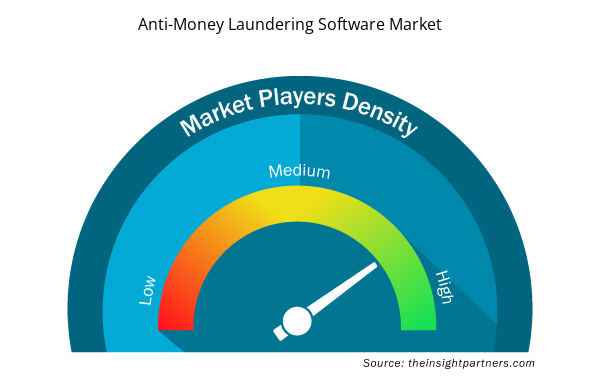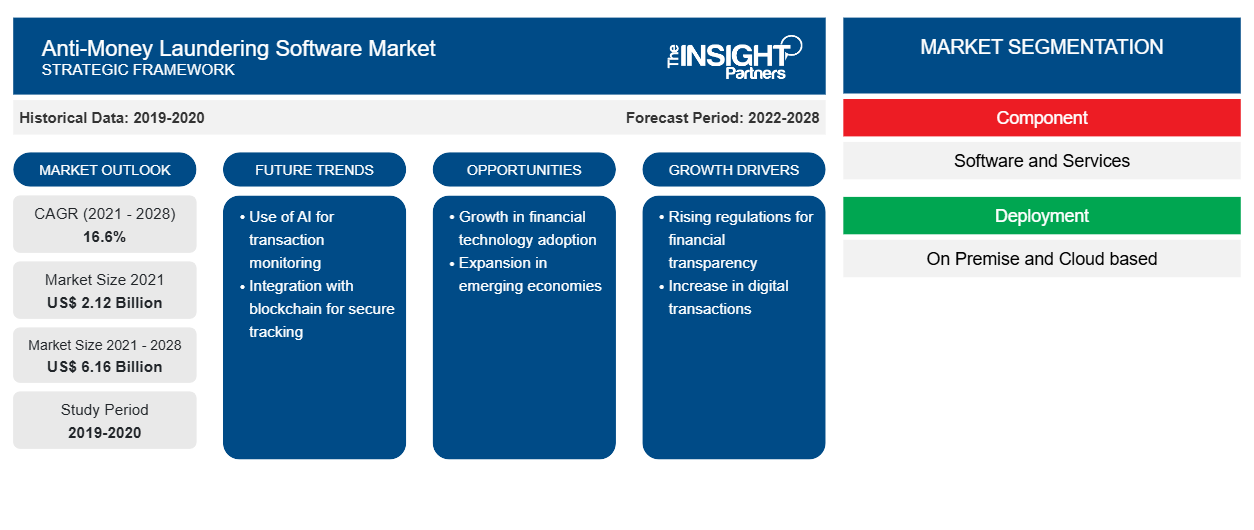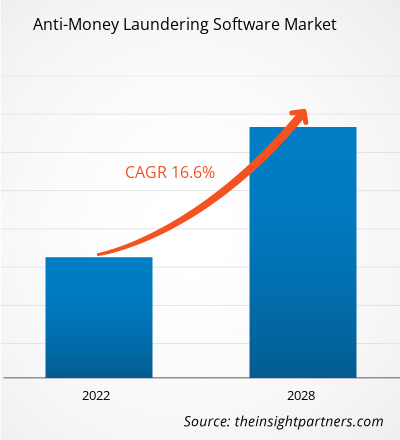[Forschungsbericht] Der Markt für Software zur Geldwäschebekämpfung soll von 2.116,3 Millionen US-Dollar im Jahr 2021 auf 6.162,8 Millionen US-Dollar im Jahr 2028 wachsen. Von 2022 bis 2028 soll der Markt für Software zur Geldwäschebekämpfung mit einer durchschnittlichen jährlichen Wachstumsrate von 16,6 % wachsen.CAGR of 16.6% from 2022 to 2028.
Technologische Fortschritte lassen die Zahl der Cyberkriminellen ansteigen. FinTech-Unternehmen haben jedoch das Potenzial, Banken auf der ganzen Welt dabei zu helfen, auf dem Weltmarkt wettbewerbsfähig zu bleiben. Der Einsatz robusterer Systeme in Kombination mit fortschrittlichen Technologien zur Verfolgung digitaler Währungen , maschinellem Lernen und der Verknüpfung von Daten hat Möglichkeiten zur Bekämpfung der Geldwäsche eröffnet. Mit der zunehmenden Akzeptanz bei den Verbrauchern und den daraus resultierenden Transaktionsvolumina in wettbewerbsfähigen FinTech-Unternehmen im Jahr 2019 wechselten viele Unternehmen zu automatisierten Verfahren zur Geldwäschebekämpfung. Die automatisierten Systeme zur Geldwäschebekämpfung liefern im Vergleich zu denen, die durch herkömmliche Daten und Technologien erzeugt werden, eine vernachlässigbare Anzahl falscher Positivergebnisse. Dies reduziert die negativen Auswirkungen falscher Positivergebnisse und hält die Betriebskosten im erwarteten Rahmen.
Angesichts der wachsenden Verbindung zwischen FinTech- und AML-Lösungen kündigte die Association of Certified Anti-Money Laundering Specialists im Dezember 2020 die Einführung eines neuen Zertifizierungsprogramms für FinTech-Unternehmen an, die regulatorische Standards erfüllen möchten. Der Verband entwickelte in Zusammenarbeit mit FINTRAIL auch das Programm Certified AML FinTech Compliance Associate. Das Programm wurde entwickelt, um das Compliance-Toolkit von FinTech-Mitarbeitern zu erweitern, die auf Einstiegsebene in der Prävention von Finanzkriminalität arbeiten. Der zunehmende Fokus von FinTech auf die Implementierung von AML-Lösungen treibt somit das Wachstum des Marktes für Software zur Geldwäschebekämpfung
voran. Die Kunden haben keine Kontrolle über den Standort der Infrastruktur. Dies bedeutet, dass das Unternehmen bei einem Angriff auf das Rechenzentrum eines Anbieters keine Kontrolle über die Dauer des Ausfalls oder darüber hat, welche Daten möglicherweise freigegeben werden. Alle Kunden in Clouds teilen sich denselben Infrastrukturpool mit engen Sicherheitsvorkehrungen, Konfigurations- und Zugänglichkeitsunterschieden. Wenn man die Kontrollbeschränkungen, Sicherheitsrisiken und Richtlinieneinschränkungen außer Acht lässt, gibt es mehrere Situationen, in denen eine Cloud-Bereitstellung besser geeignet ist. Allerdings sind Clouds im Vergleich zu On-Premise-Bereitstellungen größer, wodurch Unternehmen, die mit Clouds verbunden sind, von nahtloser, bedarfsgerechter Skalierbarkeit profitieren. Die Cloud-Bereitstellung ist ideal für Organisationen, die bereit sind, Analyselösungen mit geringen Investitionen einzuführen. Sie ermöglicht es Unternehmen hauptsächlich, die Daten mit all ihren Diensten zu beschaffen, jedoch zu einem wirtschaftlichen Preis.
Passen Sie diesen Bericht Ihren Anforderungen an
Sie erhalten kostenlos individuelle Anpassungen an jedem Bericht, einschließlich Teilen dieses Berichts oder einer Analyse auf Länderebene, eines Excel-Datenpakets sowie tolle Angebote und Rabatte für Start-ups und Universitäten.
- Holen Sie sich die wichtigsten Markttrends aus diesem Bericht.Dieses KOSTENLOSE Beispiel umfasst eine Datenanalyse von Markttrends bis hin zu Schätzungen und Prognosen.
Regionale Einblicke in den Markt für Anti-Geldwäsche-Software
Die regionalen Trends und Faktoren, die den Markt für Anti-Geldwäsche-Software im Prognosezeitraum beeinflussen, wurden von den Analysten von Insight Partners ausführlich erläutert. In diesem Abschnitt werden auch Marktsegmente und Geografien für Anti-Geldwäsche-Software in Nordamerika, Europa, im asiatisch-pazifischen Raum, im Nahen Osten und Afrika sowie in Süd- und Mittelamerika erörtert.

- Erhalten Sie regionale Daten zum Markt für Anti-Geldwäsche-Software
Umfang des Marktberichts zur Geldwäschebekämpfungssoftware
| Berichtsattribut | Details |
|---|---|
| Marktgröße im Jahr 2021 | 2,12 Milliarden US-Dollar |
| Marktgröße bis 2028 | 6,16 Milliarden US-Dollar |
| Globale CAGR (2021 - 2028) | 16,6 % |
| Historische Daten | 2019-2020 |
| Prognosezeitraum | 2022–2028 |
| Abgedeckte Segmente | Nach Komponente
|
| Abgedeckte Regionen und Länder | Nordamerika
|
| Marktführer und wichtige Unternehmensprofile |
|
Marktteilnehmerdichte: Der Einfluss auf die Geschäftsdynamik
Der Markt für Anti-Geldwäsche-Software wächst rasant. Dies wird durch die steigende Nachfrage der Endnutzer aufgrund von Faktoren wie sich entwickelnden Verbraucherpräferenzen, technologischen Fortschritten und einem größeren Bewusstsein für die Vorteile des Produkts vorangetrieben. Mit der steigenden Nachfrage erweitern Unternehmen ihr Angebot, entwickeln Innovationen, um die Bedürfnisse der Verbraucher zu erfüllen, und nutzen neue Trends, was das Marktwachstum weiter ankurbelt.
Die Marktteilnehmerdichte bezieht sich auf die Verteilung der Firmen oder Unternehmen, die in einem bestimmten Markt oder einer bestimmten Branche tätig sind. Sie gibt an, wie viele Wettbewerber (Marktteilnehmer) in einem bestimmten Marktraum im Verhältnis zu seiner Größe oder seinem gesamten Marktwert präsent sind.
Die wichtigsten Unternehmen auf dem Markt für Software zur Geldwäschebekämpfung sind:
- ACCENTURE
- ACI WELTWEIT
- ASCENT TECHNOLOGIEBERATUNG
- BAE-SYSTEME
- Gesellschaften, beginnend mit EASTNET
Haftungsausschluss : Die oben aufgeführten Unternehmen sind nicht in einer bestimmten Reihenfolge aufgeführt.

- Überblick über die wichtigsten Akteure auf dem Markt für Geldwäschebekämpfungssoftware
- Historische Analyse (2 Jahre), Basisjahr, Prognose (7 Jahre) mit CAGR
- PEST- und SWOT-Analyse
- Marktgröße Wert/Volumen – Global, Regional, Land
- Branche und Wettbewerbsumfeld
- Excel-Datensatz



Report Coverage
Revenue forecast, Company Analysis, Industry landscape, Growth factors, and Trends

Segment Covered
This text is related
to segments covered.

Regional Scope
North America, Europe, Asia Pacific, Middle East & Africa, South & Central America

Country Scope
This text is related
to country scope.
Häufig gestellte Fragen
The Anti-money laundering software market is estimated to grow at 6162.8 million US dollars in 2028 at a CAGR of 16.6%.
The Increasing focus of FinTech on implementing automated anti-money laundering systems and Rising demand for sophisticated transaction monitoring solutions are driving the anti-money laundering software market
The Information sharing among banks and other financial institutions and Increased use of artificial intelligence are the future trends for the Anti-money laundering market.
Accenture, Open Text Corporation, Oracle, BAE Systems and SAS are the five key players holding the major market share in the Anti-money laundering software market.
North America is holding major market share of Anti-money laundering market.
Transaction Monitoring is the leading product segment in the Anti-money laundering software market.
The incremental growth of Anti-money laundering software market during the forecast period is US $ 3711.2 million.
Trends and growth analysis reports related to Technology, Media and Telecommunications : READ MORE..
The List of Companies - Anti-Money Laundering Software Market
- ACCENTURE
- ACI WORLDWIDE
- ASCENT TECHNOLOGY CONSULTING
- BAE SYSTEMS
- EASTNETS HOLDING LTD.
- OPENTEXT CORPORATION
- ORACLE CORPORATION
- NICE Ltd.
- SAS INSTITUTE
- Nasdaq Inc
The Insight Partners performs research in 4 major stages: Data Collection & Secondary Research, Primary Research, Data Analysis and Data Triangulation & Final Review.
- Data Collection and Secondary Research:
As a market research and consulting firm operating from a decade, we have published and advised several client across the globe. First step for any study will start with an assessment of currently available data and insights from existing reports. Further, historical and current market information is collected from Investor Presentations, Annual Reports, SEC Filings, etc., and other information related to company’s performance and market positioning are gathered from Paid Databases (Factiva, Hoovers, and Reuters) and various other publications available in public domain.
Several associations trade associates, technical forums, institutes, societies and organization are accessed to gain technical as well as market related insights through their publications such as research papers, blogs and press releases related to the studies are referred to get cues about the market. Further, white papers, journals, magazines, and other news articles published in last 3 years are scrutinized and analyzed to understand the current market trends.
- Primary Research:
The primarily interview analysis comprise of data obtained from industry participants interview and answers to survey questions gathered by in-house primary team.
For primary research, interviews are conducted with industry experts/CEOs/Marketing Managers/VPs/Subject Matter Experts from both demand and supply side to get a 360-degree view of the market. The primary team conducts several interviews based on the complexity of the markets to understand the various market trends and dynamics which makes research more credible and precise.
A typical research interview fulfils the following functions:
- Provides first-hand information on the market size, market trends, growth trends, competitive landscape, and outlook
- Validates and strengthens in-house secondary research findings
- Develops the analysis team’s expertise and market understanding
Primary research involves email interactions and telephone interviews for each market, category, segment, and sub-segment across geographies. The participants who typically take part in such a process include, but are not limited to:
- Industry participants: VPs, business development managers, market intelligence managers and national sales managers
- Outside experts: Valuation experts, research analysts and key opinion leaders specializing in the electronics and semiconductor industry.
Below is the breakup of our primary respondents by company, designation, and region:

Once we receive the confirmation from primary research sources or primary respondents, we finalize the base year market estimation and forecast the data as per the macroeconomic and microeconomic factors assessed during data collection.
- Data Analysis:
Once data is validated through both secondary as well as primary respondents, we finalize the market estimations by hypothesis formulation and factor analysis at regional and country level.
- Macro-Economic Factor Analysis:
We analyse macroeconomic indicators such the gross domestic product (GDP), increase in the demand for goods and services across industries, technological advancement, regional economic growth, governmental policies, the influence of COVID-19, PEST analysis, and other aspects. This analysis aids in setting benchmarks for various nations/regions and approximating market splits. Additionally, the general trend of the aforementioned components aid in determining the market's development possibilities.
- Country Level Data:
Various factors that are especially aligned to the country are taken into account to determine the market size for a certain area and country, including the presence of vendors, such as headquarters and offices, the country's GDP, demand patterns, and industry growth. To comprehend the market dynamics for the nation, a number of growth variables, inhibitors, application areas, and current market trends are researched. The aforementioned elements aid in determining the country's overall market's growth potential.
- Company Profile:
The “Table of Contents” is formulated by listing and analyzing more than 25 - 30 companies operating in the market ecosystem across geographies. However, we profile only 10 companies as a standard practice in our syndicate reports. These 10 companies comprise leading, emerging, and regional players. Nonetheless, our analysis is not restricted to the 10 listed companies, we also analyze other companies present in the market to develop a holistic view and understand the prevailing trends. The “Company Profiles” section in the report covers key facts, business description, products & services, financial information, SWOT analysis, and key developments. The financial information presented is extracted from the annual reports and official documents of the publicly listed companies. Upon collecting the information for the sections of respective companies, we verify them via various primary sources and then compile the data in respective company profiles. The company level information helps us in deriving the base number as well as in forecasting the market size.
- Developing Base Number:
Aggregation of sales statistics (2020-2022) and macro-economic factor, and other secondary and primary research insights are utilized to arrive at base number and related market shares for 2022. The data gaps are identified in this step and relevant market data is analyzed, collected from paid primary interviews or databases. On finalizing the base year market size, forecasts are developed on the basis of macro-economic, industry and market growth factors and company level analysis.
- Data Triangulation and Final Review:
The market findings and base year market size calculations are validated from supply as well as demand side. Demand side validations are based on macro-economic factor analysis and benchmarks for respective regions and countries. In case of supply side validations, revenues of major companies are estimated (in case not available) based on industry benchmark, approximate number of employees, product portfolio, and primary interviews revenues are gathered. Further revenue from target product/service segment is assessed to avoid overshooting of market statistics. In case of heavy deviations between supply and demand side values, all thes steps are repeated to achieve synchronization.
We follow an iterative model, wherein we share our research findings with Subject Matter Experts (SME’s) and Key Opinion Leaders (KOLs) until consensus view of the market is not formulated – this model negates any drastic deviation in the opinions of experts. Only validated and universally acceptable research findings are quoted in our reports.
We have important check points that we use to validate our research findings – which we call – data triangulation, where we validate the information, we generate from secondary sources with primary interviews and then we re-validate with our internal data bases and Subject matter experts. This comprehensive model enables us to deliver high quality, reliable data in shortest possible time.


 Holen Sie sich ein kostenloses Muster für diesen Bericht
Holen Sie sich ein kostenloses Muster für diesen Bericht